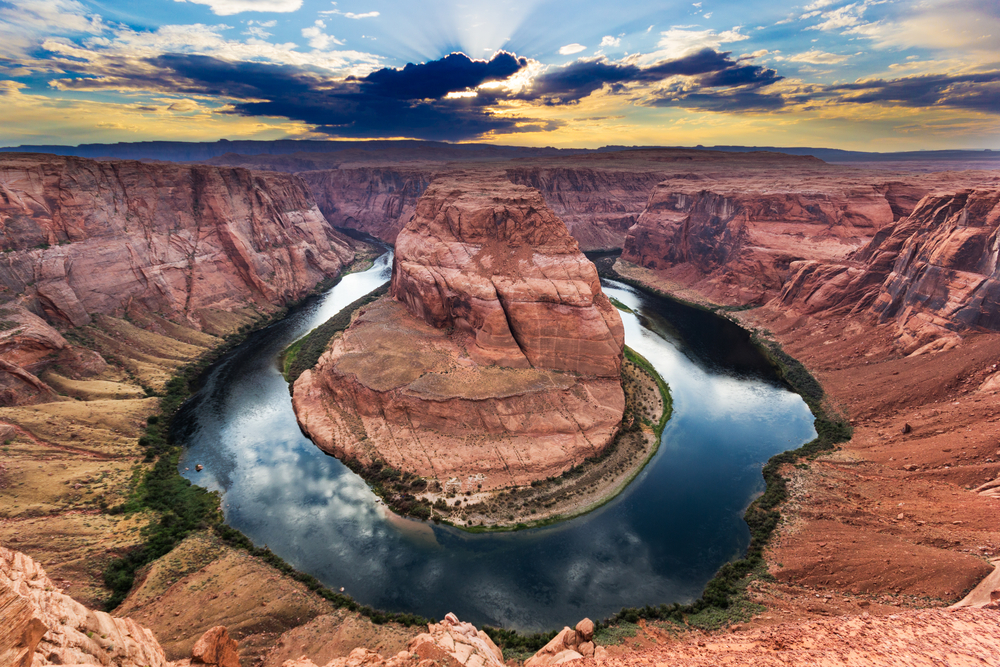Deep beneath the bleached-out, dusty surface of the drought-stricken West is a stash of water sequestered between layers of rock and sometimes built up over centuries.
Officials in the Colorado River basin states have long treated this liquid treasure as a type of environmental retirement account — an additional supply of water they can raid to get through the driest years and make up for the chronic overuse of the rivers themselves.
In recent years, the withdrawals have taken on even more importance: At least 60 percent of California’s water now comes from underground, some researchers say. Arizona, staring down imminent rationing of Colorado River water, pumps nearly half its supply from aquifers.
But in allowing their residents to tap underground resources this way, regulators and legislators in Southwestern states have ignored an inconvenient truth about how much water is actually available for people to use: In many places, groundwater and surface water are not independent supplies at all. Rather, they are interconnected parts of the same system.
The science has been clear for the better part of a century. Drawing groundwater from near a stream can suck that stream dry. In turn, using all the water in streams and rivers lessens their ability to replenish the aquifers beneath them. Farmers who drill new wells to supplement their supplies with groundwater are often stealing water from their neighbors who hold rights to the rivers above them. This understanding has been the foundation of the U.S. Department of the Interior’s water accounting for decades, and was used by the U.S. Supreme Court to decide one of the most significant water contests in history.
Yet California and Arizona — the two states water experts say are facing the most severe water crises — continue to count and regulate groundwater and surface water as if they were entirely separate.
“States have their own take on this. Or they choose to not address it at all,” said Stanley Leake, a hydrologist with the U.S. Geological Survey and a leading expert on properly accounting for the connection between ground and surface waters in the West. “In some cases they pretend that there is no connection.”
Leaders in California and Arizona acknowledge that their states have done this, at least in part to avoid the grim reckoning that emanates from doing the math accurately. There is even less water available than residents have been led to believe.
If these states stopped effectively double-counting their resources, they would have to change laws, upend traditional water rights, and likely force farmers and cities to accept even more dramatic cuts than they already face — a political third rail.
“The politics of water are more challenging than any other issue the state faces,” said Fran Pavley, a California state senator who helped draft a much-praised package of state laws passed last year regulating groundwater withdrawals for the first time.
Tucked into Pavley’s package was a little-noticed provision that explicitly prohibits California state regulators from addressing the interconnection between groundwater and surface water in local water plans until 2025, a compromise meant to give local water agencies a leisurely runway to adjust to a new way of counting.
Pavley said the prospect of more immediately acknowledging the overlap between ground and surface waters threatened to derail the legislation entirely, triggering fierce opposition from the Agricultural Council of California, the California Chamber of Commerce, and other industry groups.
“Those who have unlimited water supply don’t particularly like the idea of changing that,” she said. “You can’t manage what you don’t measure.”
Arizona law, too, treats groundwater and surface water as unconnected, as does Arizona’s state water plan, which purports to account for water resources and to estimate how many years of supply remain. Its authors know better, Arizona’s top water official acknowledged, but rewriting them to be more truthful would be politically impossible and economically damaging.
“We know for a fact that pumping aquifers can dry up rivers,” said Thomas Buschatzke, the director of the Arizona Department of Water Resources, who says his policy is bound by the legislature and court rulings. “But it is the law … it would be a huge upset to the economy to do away with that.”
The costs of refusing to acknowledge or adapt to the reality that two seemingly separate sources of water are actually often one are hard to measure but may turn out to be profound, leading hydrologists say.
In a series of articles, ProPublica has been examining the ways in which human’s mistakes in managing water in the West have exacerbated the severity of the drought and have left Colorado River basin states less able to adapt to a changing climate. There are lots of culprits: farming subsidies for water-intensive crops, arcane laws encouraging waste, leaky infrastructure, and more.
But none may be more significant than allowing a miscounting of how much water exists in the first place. Willingly overlooking the science amounts to a fundamental failure of water management, leading water experts say, one that is leading to decisions about how to use it that will deepen and prolong the drought’s painful effects. In the end, said Rich Juricich, an engineer with the California Department of Water Resources, it may mean that some places run short of the water they need.
Already, damage from the West’s increasing reliance on underground water supplies is proliferating. In parts of California and Arizona, groundwater levels are being drawn down so quickly that the earth above them is collapsing. Bridges and canals are buckling.
The more water is extracted from underground, the harder it becomes to restore the region’s rivers and reservoirs — some of which no longer flow through the summer — simultaneously sucking them dry from above and below.
“If you don’t connect the two, then you don’t understand the system,” said John Bredehoeft, a leading hydrogeologist who for many years managed the U.S. government’s western states water program for the U.S. Geological Survey. “And if you don’t understand the system, I don’t know how in the hell you’re going to make any kind of judgment about how much water you’ve got to work with.”
At about 30,000 feet above the Earth, oxygen becomes scarce, and the stratosphere begins. Hydrogeologists estimate that the part of the Earth that holds water stretches almost as deep beneath our feet. Down there, another dark, invisible frontier awaits.
If you were to slice a knife through the Earth, a cross-section would show bands of rock bent over like a bell or bent up like a bowl. When it rains, water soaks into the soil, through compacted dirt and rock, until it is blocked by an impermeable surface. There, the water can sit undisturbed for tens of thousands of years. The deeper the water, the more it is saturated with salt and minerals. But the shallowest layers — say, the first mile — can hold natural reservoirs, or aquifers, with water sweeter and cleaner than almost any other on Earth.
Ever since people figured out how to dig a hole, they have relied on this underground water. Villages from Jerusalem to central Texas were settled around wells and artesian springs. The water was hauled up by human muscle and a pulley or, eventually, with the aid of wind-powered gears.
Harnessing the power of the combustion engine allowed people to pump water from farther underground. Farmers used groundwater to turn the American High Plains — and then the West — into fertile ground for wheat and cotton and corn. Las Vegas built casinos dependent on wells.
The more water was pumped from underground, the more scientists began to ask where it came from and how much you could take before reaching a bottom.
Charles Theis, a poet and an engineer who once studied Kentucky’s geology by walking across the state, theorized that water moved in the Earth according to the same properties by which heat moved in a solid object — that is, it seeps from areas of high pressure to low pressure. “You stick a metal rod in a fire, and it takes a while for heat to get to your hand,” Bredehoeft said. “So you have to store enough heat in that rod for it to collect enough to get to your hand. Theis said that’s the way groundwater works.”
When Theis pumped water from an underground test well, he found the ground was constantly refilled from somewhere else. Over time, he concluded, the well was drawing most of its water from a stream miles away. Later experiments confirmed that stream and ground waters were often parts of the same system.
By the middle of the 20th century, this interconnectivity was considered proven. The energy industry began using models based on it to search for new oil. Environmental agencies used it to track pollution.
Today, it’s well understood that water pumped out of the ground by one person is water that otherwise would have filled a stream and met the needs of another person, said Bill Cunningham, chief of the Office of Groundwater at the USGS. “It may have ended up in the river tomorrow, or 100 years from now,” he said, “but it was going to end up in the river.”
Leading USGS water scientists say the connections are nearly ubiquitous, affecting at least part of almost every American waterway. For example, Las Vegas and a smattering of rural and tribal communities draw groundwater from wells and springs northeast of the city. The USGS determined that some of the groundwater in that area is connected over as much as 10 miles to the Virgin River, a tributary of the Colorado River, and Lake Mead. It used models and forecast that as groundwater withdrawals continue there in the future, as much as 90 percent of the supply could be drawn directly from the Colorado.
The dynamic works both ways: While streams can be drained by groundwater wells, they can be fed by underground aquifers, the USGS has found. That’s how streams continue to run even when it doesn’t rain.
New USGS research shows groundwater from rural Western Colorado makes up a larger share of the water that eventually flows to Phoenix and Los Angeles than previously thought. According to stream gages, as much as 58 percent of the water in the Gunnison River — a prominent Colorado River tributary — comes not from snowpack on the peaks above but from groundwater.
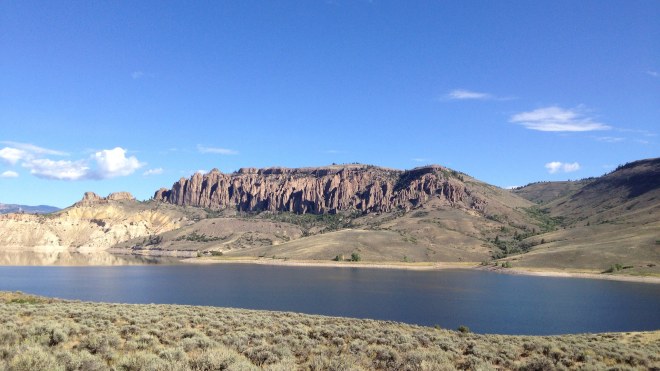
Along the Gunnison River. jimmy thomas
Even as the understanding about interconnectivity has grown, western states have taken radically different approaches to regulating surface water and groundwater. The use of surface water is governed by more than a century of law and, in the case of the Colorado River, divided down to the gallon under a seven-state compact and state laws.
The pumping of groundwater, by contrast, has been left largely unregulated for the better part of the past century across California and parts of Arizona. Other states regulate their groundwater to varying degrees (Arizona does in certain populated areas) but have also been inconsistent in recognizing the connections and overlaps between their resources. Farms have drawn hundreds of millions of gallons to spread across crops, pumping more in dry years to make up for what rivers could not provide. New subdivisions have put in wells for thousands of households.
The West has consumed these resources ravenously, as if they were bottomless. By 1965, scientists measured that parts of the aquifer beneath Las Vegas had dropped by more than 75 feet. Arizona officials estimated the state’s aquifers had dropped by as much as 500 feet by 1980. By 2004, USGS scientists estimated— based on modeling — that the region south of Denver had drawn down water levels by more than 900 vertical feet.
In some places, so much water has been drained from underground, the effects can be seen with the naked eye. A USGS scientist’s 1977 photograph near the town of Mendota in Central California uses a telephone pole to show how the ground had effectively collapsed, sinking some 30 feet.
Anyone who recognized these telltale signs would worry that the West’s groundwater was approaching a state of crisis. But even as the drought began and then worsened, with surface water vanishing, the West dug in and doubled down — replacing dwindling reservoirs with new water pumped from underground.
Today, the Colorado River states consume more than 21 billion gallons of groundwater each day — adding up to 1.5 times the flow of the Colorado River itself each year.
In 2009, Jay Famiglietti, now a scientist researching underground water in partnership with NASA’s Jet Propulsion Laboratory in Pasadena, Calif., set out to quantify just how much groundwater had been lost over time.
NASA had a pair of satellites that gathered data on subtle changes in the Earth’s mass by measuring almost indiscernible shifts in gravitational forces during orbit. Famiglietti and his team of doctoral students at the University of California Irvine, where he also teaches, thought they could tease out which parts of those gravitational shifts were due to a changing volume of water inside the Earth’s crust.
The team determined that aquifers were shrinking at an astonishing rate in Asia, North Africa, and across the globe. The western United States stood out.
“It was among the worst in the world,” Famiglietti said. “The rate of decline is much steeper than the rate of decline of the reservoirs. While everyone is looking at the surface water, no one is looking at the groundwater, and it’s disappearing at a rapid clip.”
Famiglietti and his team determined that some 13 trillion gallons of water had been lost from underground reservoirs in the Colorado River basin since the NASA satellites began collecting data in late 2004. To put that figure in perspective, it’s nearly 1.5 times the total capacity of Lake Mead — the nation’s largest reservoir and the West’s most important — and as much water as the state of Arizona uses in six years.

Lake Mead.welmoe
The research suggested the seven-state Colorado River basin region was actually using about one-third more water each year than its river budget alone allowed. In separate research Famiglietti looked at California’s aquifers — which lay outside the Colorado River basin — and found that they had also been severely diminished, having dropped by about 7 trillion gallons since just 2011.
“We are living in ignorance here in California, and in Phoenix, and in Scottsdale, and in Las Vegas,” said Stephanie Castle, the doctoral student who led much of the research.
Other research conducted by the USGS in Arizona suggests that because of huge delays in the way things unfold inside the Earth, even if all the groundwater pumping stopped tomorrow, the hydrologic suck out of the Colorado River basin might increase for another 40 years as the aquifers there sought to regain their balance.
“We can’t keep doing this forever,” said Famiglietti, the NASA scientist. “We’re heading towards the bottom.”
Arizona was the rare state to identify the overuse of groundwater as a threat early on.
In 1980, the state passed what amounted to a landmark groundwater act requiring its Department of Water Resources to identify where groundwater was being depleted the fastest and to set limits on how much water could be pumped there. The state designated “active management areas” — mostly around its cities and farming regions — and then, in effect, distributed rights to harvest groundwater much the way it had distributed rights to surface waters years before on a strict first-come-first-served basis.
Later, the state regulators established tough rules forcing housing developers in those management zones to prove they had access to 100 years’ worth of water before they could get permits to build, and setting limits on how much of it could come from underground. And when the state’s water canal, built to transfer water hundreds of miles from the Colorado River, began to deliver copious new supplies, Arizona pumped that water back underground, with the goal of restoring its beleaguered aquifers.
But exceptions were allowed that diluted the effect of those efforts as quickly as they were launched. In a concession to developers who feared they couldn’t secure long-term water supplies, the state passed a law in 1993 allowing them to pump groundwater in excess of their limits in one place, but then pay for more Colorado River water to be re-injected underground by newly created replenishment districts in another. Developers used the loophole far more than was anticipated, drawing heavily on groundwater, and the cities sprawled. Today the state, having created what University of Arizona professorRobert Glennon calls “an end run” around the law by essentially lending the water to builders on paper, has run up an enormous deficit; its districts project that within 10 years they will owe their aquifers more than four times as much water as they have access to — 65 billion gallons each year.

Bruce Babbitt.The Aspen Institute
Bruce Babbitt, who as governor signed Arizona’s 1980 groundwater act and later served as U.S. Secretary of the Interior, attributes the state’s retreat on groundwater conservation to the powerful agriculture and development lobbies.
“There is no question that the various economic groups have consistently begun to undermine the provisions in the act,” Babbitt said.
There were other exceptions made, too. One rule allows farmers who were supposed to stop pumping groundwater to resume pumping — almost without limits — so long as they use modern irrigation practices that use that water efficiently. Homebuilders found they could circumvent limits on groundwater pumping for large residential developments by building just a few homes at a time, because single homes could drill new water wells without a permit.
The result is that today, following decades in which the state continued to recharge its aquifers (and had some success with this beneath parts of the larger cities), 61 percent of the state’s groundwater basins have lower water levels than they did in 1993.
Arizona officials recognize that the continued profligate use of groundwater has also been taking its toll on the state’s badly imperiled supply of surface water. Thomas Buschatzke, the director of Arizona’s Department of Water Resources, puts it as emphatically as any scientist.
“Groundwater pumping can reduce the stream flow and eventually dry up the streams,” Buschatzke said, nodding to the scientific consensus and at least one federal study that documented the phenomenon on Arizona’s Verde River.
Today, the state’s most significant natural waterways are mostly tapped out. The Gila River, which runs from the mountains of New Mexico all the way to the junction of Arizona’s westernmost edge and the Mexican border, is diminished to a trickle by the time it reaches its confluence with the Colorado. Its biggest tributaries — the Salt and the Verde — are often stopped dead at a dam east of Phoenix, if they don’t run dry before they get there.
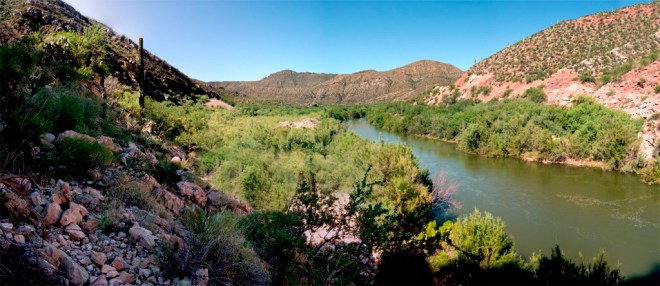
Gila River.Alan Stark
These rivers have been emptied in part because the people who live beside them continue to drill water wells along their banks. Because of the interplay between the rivers and groundwater, they know that’s where they will find water. And Arizona, with its loosened groundwater enforcement, has let them. Year after year, as the rivers and streams have dwindled, the state’s Department of Water Resources, which requires permits, has continued to issue them, allowing new groundwater wells, and not counting their withdrawals as part of a single system.
David Roberts oversees water rights and policy for the Salt River Project, one of the state’s largest public water and power utilities, which is suing landowners over their groundwater wells. Roberts says that in the absence of laws recognizing that groundwater and surface water are pulling from the same source, people will continue to do what benefits them most, which is tap into the ground for water where they know they’ll find it.
“The easiest way to get water is to drill a well, so you have lots of wells, thousands of wells, near the stream,” Roberts said.
Buschatzke, the state water official, acknowledges that none of this is wise: the continued overuse of groundwater and the refusal to note and act upon the fact that surface water and groundwater are connected. But he says he is barred by law from actually applying that knowledge in regulating how much water Arizonans use every day, every week, every year. It’s been that way since 1931, when Arizona’s Supreme Court ruled that ground and surface waters were separate.
“We really have a bifurcated system, and there is largely not legally a connection between the groundwater aquifer and the stream flows,” Buschatzke said of the state of Arizona’s laws. Changing it might bring economic turmoil because Arizona’s economy has grown up based on that system.
As a result, he said, “We do not attempt to determine how much of the pumping might be depleting the stream flow.”
The implications are considerable.
In 2014, Arizona’s Department of Water Resources issued a plan for sustaining the state’s water supply into the future. It predicted that Arizona’s population would grow by 50 percent over the next two decades and that the state’s residents and industries would need at least 19 percent more water than they consume today.
Even without a proper accounting of overlapping water supplies, the plan warned that demand for water could “outstrip existing supplies” by 2035 unless the state pursued dramatic solutions like desalinating and piping in ocean water or artificially seeding clouds to make it rain. Though the report doesn’t state it, calculations based on figures within it suggest the shortfall could come much sooner — in as little as eight to 10 years. The pain, the report said, would be distributed broadly and affect just about everyone. (Arizona’s water department says both population and demand have been increasing slower than it had expected, relieving the threat of a shortage, but it has not released new estimates.)
All of these forecasts would, of course, be worsened if the state plan accurately counted surface and groundwater supplies, reducing the total to reflect the overlap between the two. The state’s earlier water plan from 2011 says as much, warning that the failure to account for the interconnections “may also damage the state and local economies.” Deep in a 685-page document that is part of Arizona’s state water plan, the state lists 42 groundwater basins that it says are connected to surface water, indicating a potential conflict with stream water rights. It’s nearly impossible to tell how much water would flow from one into the other, but figures in the documents make it clear that the water sources are heavily relied on as sources of both groundwater and surface supplies at the same time.
For the law governing how to count water to change now, the legislature would have to vote on it. But that’s proved elusive, Buschatzke said, and Arizona’s elected officials have been steered away from action by farmers and industries that understand that a change would inevitably mean drastic cuts in their water.
“The issue comes up,” — in briefings and informal conversations — he said, but farmers, some cities and big industry advocate for the status quo. “And there is never enough consensus among the opposing factions to even get far enough to draft the legislation.”
“This is not perceived by people in the legislature as a major issue that they want to invest their political capital in,” said Rhett Larson, an associate professor of Law at Arizona State University and a senior research fellow at the Kyl Center for Water Policy, whose family has farmed in Arizona for generations. “If we draw the line more brightly, then someone is going to end up on the wrong side of that line.”
Jon Kyl, the former three-term senator and four-term congressman from Arizona who is behind the Kyl Center, said he thinks a legal change is not just due, but also inevitable.
The drought may just be severe enough to compel that.
“It has to come to a head, because there are literally thousands of wells which could be taking surface water,” Kyl said. “And eventually that’s got to be sorted out.”
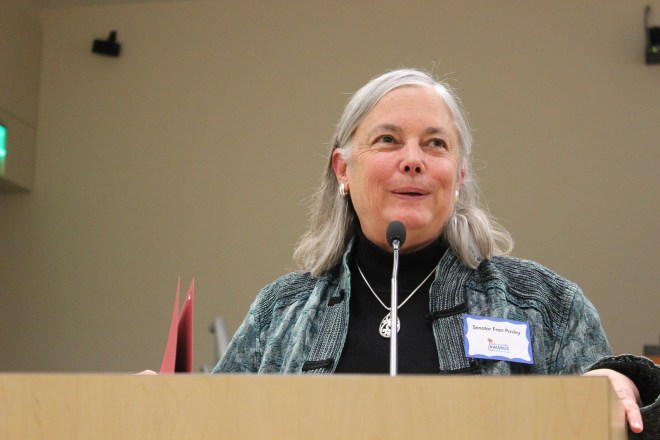
Sen. Fran Pavley.California Air Resources Board
In February 2014, Pavley, the California state senator, saw her best chance in years to change the way California managed its groundwater supplies.
The governor had released a water plan, an assemblyman had proposed more modest groundwater regulations, and the drought was worsening. She wanted to reform forever the way the state accounted for its water. But it didn’t figure to be easy.
California, after all, had never even bothered to count its groundwater — how much it had or how much it was withdrawing.
It had tried. The state lets its local water agencies govern groundwater, but in 2002 it mandated that those agencies could receive state funds only if they set up groundwater management plans and investigated whether a connection between surface and groundwater existed. Fewer than half the state’s water districts ever complied, and only 17 percent of the state’s groundwater area has ever been examined, the state’s Department of Water Resources recently reported. According to Rich Juricich, an engineer with the California Department of Water Resources, California had endured the early years of the worst water crisis in centuries with nothing more than “a general idea” of how much water was actually available.
Pavley, a liberal Southern California legislator who has chaired the state’s water committee for the past seven years, was convinced it was time for a step forward. She rallied support among interest groups, embraced the assembly measure and wrote two more ambitious bills to drive the agenda: The bills would for the first time require the state — through its local agencies — to determine how much groundwater it had, how much was being taken and what effect that was having on the state’s surface water supply.
“Timing is everything,” Pavley said. “Our being the last of the western states to manage our groundwater basins resonated, at least with a majority of the legislators.”
The pushback against the efforts was fierce.
“What part of agriculture are we going to dewater and put out of business?” asked Danny Merkley, a farmer and director of water resources for the California Farm Bureau Federation, in an interview with ProPublica. The bureau was among the most influential organizations that lobbied against the bills.
Pavley’s opponents argued that the connection between surface and groundwater varied. Farmers insisted they needed more time to adjust to a world where water was properly counted because it would inevitably mean that less of it would be doled out. Some claimed the bills amounted to gross overreaching by the government.
No one denied the science.
“California has treated surface water and groundwater as distinct items, so there were those who didn’t want to change that,” said a state Senate staff member close to the negotiations. “Most of the agricultural interests were opposed: the Agricultural Council of California, the Association of Egg Farmers, the Bean Shippers Association, the Farm Bureau Federation, dairy farmers.”
In a position paper prepared last August and recently sent to ProPublica, the California Chamber of Commerce, which lobbied against the groundwater legislation, said Pavley’s bills aimed at better counting and regulation would set off an explosion in costly and lengthy litigation. The paper warned of “a veritable feeding frenzy for environmental attorneys.”
Those pushing back prevailed. Last September, the Sustainable Groundwater Management Act was signed into law. It amounted to far less than Pavley and others had hoped. California authorities will not even begin counting groundwater withdrawals for a decade. And, explicitly, the state is barred for 10 years from any effort to “remedy a condition where the groundwater extractions result in significant depletions of interconnected surface waters.”
Pavley, for her part, is proud of what was achieved. “You never get everything you want, but you have to start somewhere,” she said.
She regards the law as a critical and substantial step that promises to close a gaping hole in the way California manages its water. For her, merely putting the surface and ground water connection on the record is significant, given the state’s history and the interests at play. She only wishes the law’s teeth would bite sooner.
“So it’s going to take up to 20 years to implement a sustainable groundwater management plan,” she said, “and if you are overdrafting today and you are in the middle of a severe drought, of course it doesn’t seem like this is fast enough, but it is complicated.”
Those who will implement the plan urge patience.
“You have to take this a step at a time, and it’s something I don’t think we can just turn around overnight,” said David Gutierrez, the Department of Water Resource’s manager for the state’s Sustainable Groundwater Program. “It’s going to take us a while to get out of the hole and figure out what we are doing in the future. This legislation is not to fix the problems of yesterday, it’s to fix the problems of tomorrow.”
“Should we have done this decades ago?” he adds, “Heck yeah.”
What California and Arizona are both so reluctant to accomplish, the federal government has been routinely doing for more than 50 years: counting the waters it controls as from a single source, and using an honest estimate of the total to determine the resources available for people to use.
But that kind of accounting is far from easy, and it requires vigilance.
Paul Matuska is the closest thing the American West has to a water cop, and his beat includes Needles, Calif., a dog-eared desert town midway between Flagstaff, Arizona, and Los Angeles.
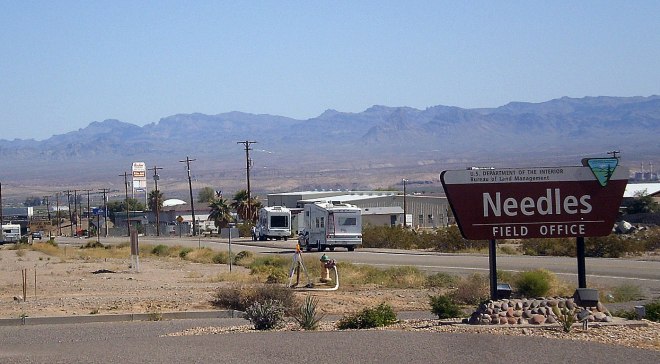
Needles, Calif.James Brooks
About 4,800 people live in Needles, on the western banks of the Colorado River where it cuts a swath in the mud between California and Arizona. An old railroad town and the gateway to the farmland of the Fort Mojave Indian Reservation across the river, Needles has 16 churches, seven gas stations and an 18-hole golf course.
Matuska, a hydrologist, manages a small group of accountants for the federal Bureau of Reclamation, which controls water distribution along the lower half of the Colorado River. His job is to count the water used by towns like Needles and the farms around them — lands close by the legendary and essential Colorado — and make sure they don’t take more than their share of the river.
“We’ve been doing this for a long period of time,” Matuska said. “The Colorado River basin is definitely a resource that we want to protect.”
Needles, despite its proximity to the physical river itself, gets most of its water from underground — pumping hundreds of million gallons a year from four wells drilled into the local aquifer. But if you could dive beneath the Earth near Needles, you’d discover a subterranean valley packed with porous gravel. That gravel is filled with water, a shallow aquifer that Needles taps to sprinkle its golf greens and feed its taps.
Even as Needles pumps the water from its underground valley, the water level in the wells never drops. Instead, water rushes toward it, underground, from the direction of the river. The nearby Colorado essentially flows beneath the surface, spilling away from the riverbed and filling the bathtub of the valley for miles in either direction. Of course, the seemingly separate sources of water are actually one and the same.
Matuska’s job is to make sure that’s the way the water is counted.
He estimates that the wells in Needles draw an average of about 700 million gallons of groundwater annually that, in truth, ultimately comes from the Colorado River. Technically, that water has already been doled out, with strict budgets allowed for each of the states along the river. And so to avoid double counting the valley’s resources, Matuska subtracts the water Needles uses from the amount California is allowed to pump into its canals and ship to Los Angeles and elsewhere each year.
But the federal government has the authority to take this approach only in the few places where it has direct control, slender swaths of land adjacent to the Colorado. So long as it is not being distributed through a federal facility, the feds leave the rest of the West’s water — its counting and its distribution — to the states and their laws.
And so Matuska and a dozen or so other scientists who make up the bureau’s accounting team stick to what they can change: analyzing the Colorado River aquifers through small towns from Needles to Blythe to Yuma.
On patrol one day last fall in Blythe, another California town along the Colorado, Matuska drove his SUV looking for large green lawns in rural areas that he hadn’t noticed before — a new farm field or some other sign of small-scale irrigation bringing life to a red desert. When he can’t see from the roads, he scans satellite images, looking for patches of green that haven’t already been accounted for. He wants to know, and report, how much water was used to create such little wonders.
The city of Blythe estimates its wells draw more than 1.2 billion gallons of groundwater annually that Matuska says ultimately come from the Colorado, and he counts it — through complex calculations — as part of the much larger amount of river water used by a farming district surrounding the city. Matuska estimates that on the whole, California water users in the area draw more than 2 billion gallons of groundwater from the Colorado River each year, which, through his strict accounting, is then properly factored into the state’s larger water math.
As for the continued failure of the states to do likewise, Matuska has little understanding or sympathy.
“To the degree that you want to maintain a long-term sustainability, you need to factor the entire hydrologic system into your decision,” Matuska said. “I don’t know how else to say it.”
This story was co-published with Matter, a new digital magazine on Medium. Follow ProPublica on Medium for more conversation on the West’s water crisis.
Naveena Sadasivam and Lauren Kirchner contributed to this story.

